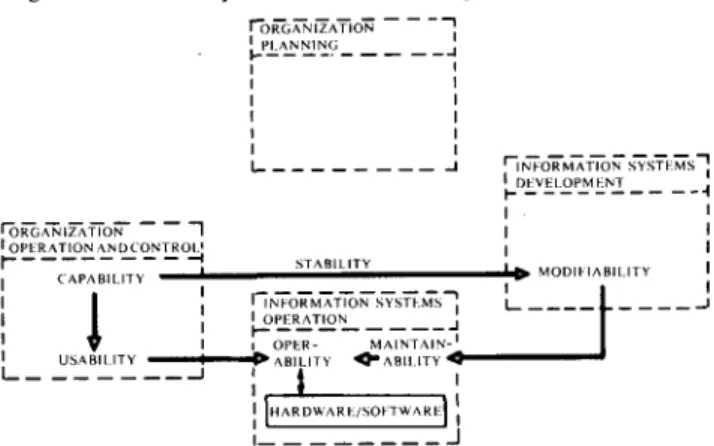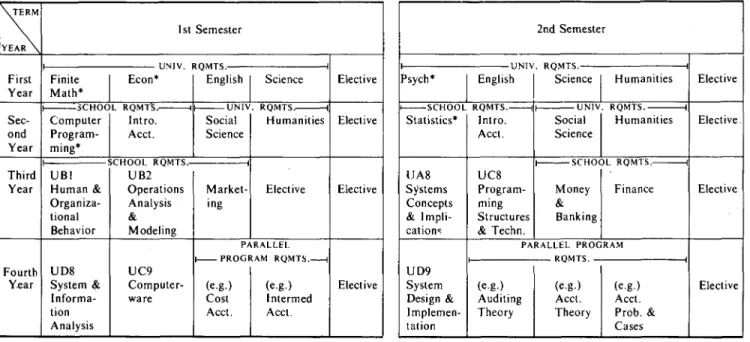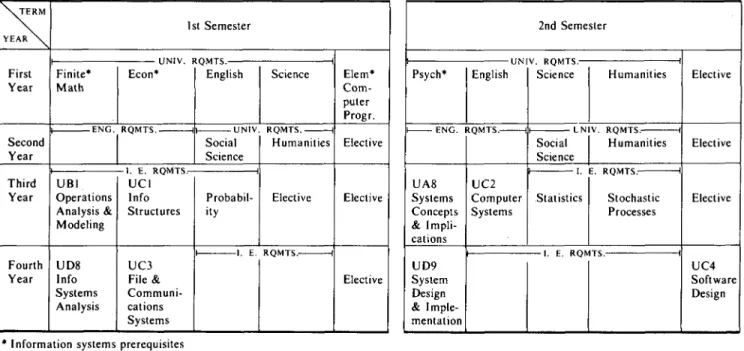A classification of the fields of computer science is presented and twenty-two courses in these fields are described. Chapter 8 discusses some of the problems in implementing a computer science curriculum.
Descript
This course introduces the student to the basic algebraic, logic and combinatorial concepts from the topics needed in the subsequent computer science courses and shows the applications of these concepts to different areas of computer science. The course deals with one of the most fundamental — but often insufficiently recognized — areas within computer science.
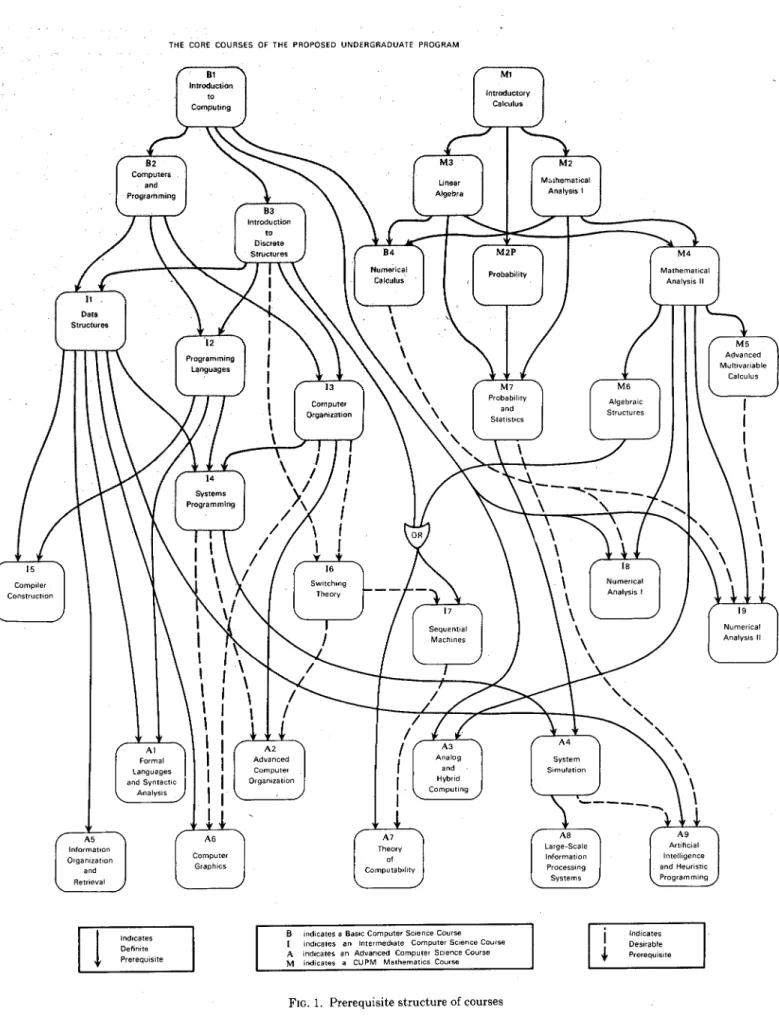
This course provides him with an introduction to the basic numerical algorithms used in scientific computer work - thus supplementing his studies in beginning analysis - and gives him an opportunity to apply the programming techniques he has learned in the B l course. . Because of these goals, many of the elementary numerical analysis courses now offered in the m a t h e m a t i c s d e p a r t m e n t cannot be considered substitutes for this course.
Includes elementary discussion of errors, polynomial interpolation, quadrature, linear systems of equations, solution of nonlinear equations, and numerical solution of ordinary differential equations. Its purpose is to introduce the study to the relationships that exist between the elements of data involved in problems, the structures of storage media and machines, the methods useful for representing structured data in storage, and the techniques to work. on d a t a structures.
- Undergraduate Programs
- Master's Degree Programs
- Doctoral Programs
- Service Courses, Minors, and Continuing Education
- Implementation
Those responsible for the basic computer service courses must certainly be aware of the needs of the courses for which these courses are intended. Emphasis should be placed on the overall structure of the machines and programming techniques considered.
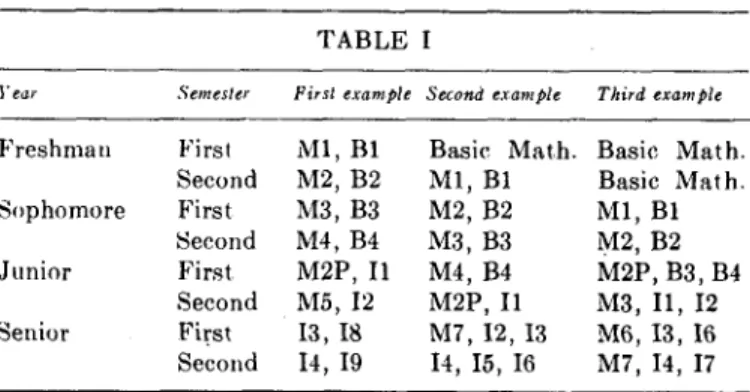
Data Structures (3-0-3)
Designed as a text for a three-hour, one-semester course for engineering and science undergraduate students. Designed as a text for a one-semester course for advanced undergraduate students in science and engineering.
Proceedings of ACM symposium on symbolic and algebraic m a n i p u l a t i o n , Washington, D. A n u m b e r of languages for symbolic and algebraic m a n i p u l a t i o n are described in this special issue. This paper lists the ambiguities that remain in A L G O L 60 and that have been noted since the publication of the Revised.
General introduction to the structure of these systems, the techniques involved in their construction, and some of the problems involved in their implementation. Based on some of the early systems such as Sage, Project Mercury, Saber and P a n a m a c.
International Computation Center (ed.) Symbolic Languages in Computing, Proceedings of the Symposium in Rome, March. A very mathematical and broad coverage of both combinatorial coupling theory and sequential machine theory.
Most areas of a u t o m a t theory are covered with the exception of commutation theory and other engineering topics. A collection of many of the early papers on finite automata, Turing machines, and the synthesis of a u t o m a t a that stimulated the development of a u t o m a t theory.
A well-written paper containing the first statement of many of the most important results of context-free languages. Introduction to Turing machines (TMs) and the invariance of general computability under changes of the model.
A Report of the ACM Curriculum Committee on
L. Ashenhurst Editor
Curriculum
Recommendations for Graduate Pro-
The need for education related to informa- tion systems in organizations is discussed,
Key Words and Phrases: education, man- agement systems, systems analysis, management
CR Categories: 1.52, 3.51
Contents Preface
Preface
- Introduction
- Detailed Descriptions and References for Course G r o u p A
- Detailed Descriptions and References for Course G r o u p B
- Detailed Descriptions and References for Course G r o u p C
- Detailed Descriptions and References for Course G r o u p D
- presents a set of 13 courses which en- compass the material needed to achieve the program
- discusses aspects of implementing effec-
- gives conclusions and acknowledgments
- Information Systems Development
This report provides recommendations for a graduate professional program in information systems development, at the Masters level. The program is intended for the education of individuals who will develop complex information systems.
PTANNING
In contrast, but equally important, the system must respond to inevitable changes in organizational requirements. The attributes that the system must have to meet their needs can be characterized as usability, operability and maintainability respectively.
MAINTAI- NABILITY ^
The Development Process
2.3], In these terms the function of the information processing department becomes analogous to that performed by. The developers of information systems must therefore be aware of the central aspects of both organizational systems and computer systems.
Information Systems Positions
Like consulting firms, these companies deal with other organizations that represent a variety of information systems applications. The problems of developing information systems are as difficult or more so for these or-.
Educational Needs
Other advanced jobs for information technology professionals are emerging as information systems become increasingly integrated into the organizational structure. In addition, knowledge of audit procedures, legal requirements and other external aspects of the use of information systems is required.
3.Curriculum Requirements
The main focus of the present recommendations is thus an independent postgraduate professional program in the development of information systems leading to a master's degree [1, sec. 3.4], these options would give a touch of the organizational-technological balance needed to effectively deal with information systems, as well as give some exposure to information systems development methods.
- Output—Characteristics of Graduates
- The Educational Process
- Input—Prerequisites
- Courses
- Course Group A: Analysis of Organizational Systems
- Course Group B: Background for Systems Development
- Course Group C: Computer and Information Technology
- Course Group D: Development of Information Systems
- Programs
- Schedule for a Two-year Program
- Schedule for a One-year Program
- Options in MBA Degree Programs
- Options in Computer Science Master's Degree Programs
- Options in Other Graduate Programs
- Implementation
The presence of the material here in the curriculum provides an additional opportunity to specifically include it in the context of information systems. Materials from other fields are used in the systematic study of the development process of information systems.
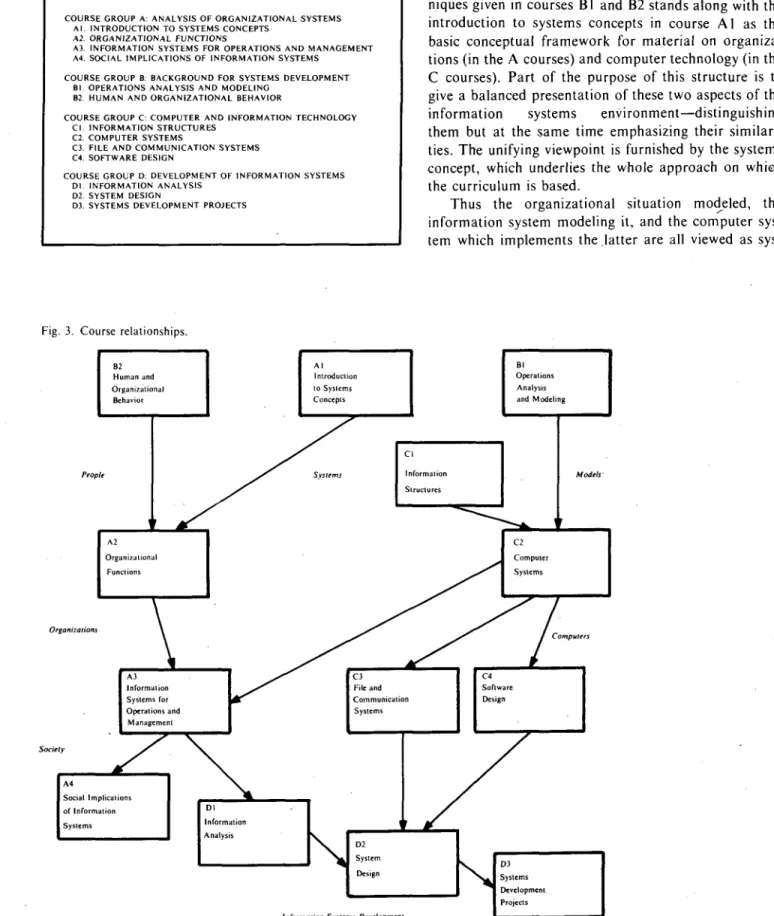
- Institutional Considerations
- Course Interactions
- Instructional Materials
Proficiency must be acquired for teaching materials that are not common to the department or school offering the program (e.g., the technical materials for the business school, the organizational materials for the computer science department). Three of these themes are: (a) the use of computer techniques; (b) the use of formal models; and (c) a pragmatic approach to human behavior. a) The use of computer techniques.
Appendices
The committee members presenting this report (listed in the preface) would welcome the opportunity to comment on the proposed programs, as well as specific questions about these recommendations and further feedback. The following people assisted the Committee at one stage or another in the drafting process prior to the final preparation of the report.
Appendix A. Detailed Descriptions and References for Course Group A
An example of a basic book presenting the essence of the so-called "Management Information Systems" concept. Prentice-Hall, Englewood Cliffs, N.J. The first part of the book entitled "Euphoria" is very interesting.
Appendix B. Detailed Descriptions and References for Course Group B
Tomeski (1970) and Withington (1969) provide insights into the impact of computers on organizations and people. In-depth discussion of the myth and reality of the computer's impact on people.
Appendix C. Detailed Descriptions and References for Course Group C
Detailed treatment of the initial stages of the system life cycle—. system analysis and design. See also note in bibliography for subject group C. Technical aspects of communication network design.
Education
The ACM Subcommittee on Small College Programs of the Committee on Curriculum in
Implementation problems are discussed, specifically within the constraints of limited faculty and for the
Detailed descriptions of four courses are given;
Key Words and Phrases: computer science education, course proposals, small colleges, programming course,
CR Categories: 1.52
This report gives recommendations for the content, implementation, and operation of a program of com-
The Program
Four courses are described and suggestions are made for additional study and courses for students interested
For example, in course 3 no particular assembler would be studied, but the general concept and vocabulary of computer systems would be introduced. Where possible and appropriate, students are expected to use the programs and databases that are available.
Implementation
H o u g h p r o g r a m i n g would be an integral part of the course, some of the overall descriptive nature of the program would be involved. For example, if the class studied simulation, it would be appropriate for the student to gain experience using a computer-based traffic flow simulation to study the I/O issues involved and possibly by studying some of the techniques involved. in writing appropriate programs, but not necessarily in writing the program itself.
Courses
3 Credits)
Introduction. This is a first course which emphasizes good programming techniques in a higher level lan-
- Overview of problem solving process, beginning with the problem statement and ending with verifica-
- Introduction to the specific computer environment in which the student will work. Information needed by
- Simple data structures and list processing. Pointers;
- Limitations of FORTRAN. Nonnumeric programming;
- Examinations. ( 5 % )
Segmentation of problems and programs; comments and other documents and programs; comments and other documentation; debugging; library subroutines. More detailed presentation of hardware and system softwarePresentation of hardware and system software, including registers, instruction codes, addressing, assembler, loader, assembler, and characteristics of components; peripheral units; past, present and future developments.
Texts. A language manual, either the manufacturer's or one of the numerous manuals and primers that are
Concepts and techniques used in problem solving from application areas such as CAI, data management, gaming, information retrieval, and simulation.
Outline. Neither mathematical applications nor mathematical properties of structures is included in this
Searching and sorting. Comparison and evaluation of methods; techniques for use with auxiliary memory
Additional Recommended Courses
The four courses described above are designed to service a broad segment of the undergraduate student
Each of the following specific courses could be given for special study to one or a few students or as a regular
Desirable goals for this course include proficiency in assembly language programming, particularly using the
- In addition to the above list, several collections of articles originally appearing in Scientific American have been published
- The following curriculum reports are relevant to computer science education
- The following statistical reports provide information on the status of computing as obtained from recent surveys
- Daniel Couger Editor
ACM Headquarters, 1133 Avenue of the Americas, New York, NY 10036.) . b.) Proceedings, AFIPS Fall Joint Computing Conference (annual); Proceedings, AFIPS Spring Joint Computing Conference (annual). Proceedings, Conference on Computers in the University Curriculum available through Southern Regional Board of Education, Atlanta, GA 30313.).
The need for education related to information systems in organizations is discussed, and a curriculum
Key Words and Phrases: education, undergraduate curricula, management systems, information systems,
- Organizational Concentration
- Technological Concentration
- Structure of Presentation
- of this report provides a brief description of the information systems field. Section 3 lists the
- Background on the Information Systems Specialty The previously cited reports of the Committee
Background on the Information Systems Specialty The previously cited Committee reports The previously cited Committee reports provide background on information systems degree programs. Estimates of the number of openings in various occupations based on Labor Bureau reports are summarized in Table I.
2,3. Need for Differing Educational Levels
- A minimal level is required for persons who are users of the results of computer processing. This level
- At the other end of the educational spectrum is the person who is preparing for a career as an information
- Education for Users. Earlier work of the Com- mittee reported the status of education for users of the
- Coverage of computer fundamentals, systems analysis, and design and programming through a course
- Coverage of the applications of computers through incorporation of this material into the func-
- Coverage of computer capabilities for abetting decision making in a dynamic business environment
- Coverage of integration and optimization of computer applications through a course on design and
- Education for Information System Specialists
- Approach to the Specifications for Undergraduate Curricula
- Requirements
- Output Qualifications
- Prerequisite Qualifications
- Course Descriptions
- courses prepared for the two undergraduate concentration options are listed in Figure 1. Of these,
For example, acquiring the ability to develop specifications takes considerably more time than simply understanding the specification development process. One major limitation of an undergraduate program that a concentrated graduate program does not have is the amount of exposure to the prototype.
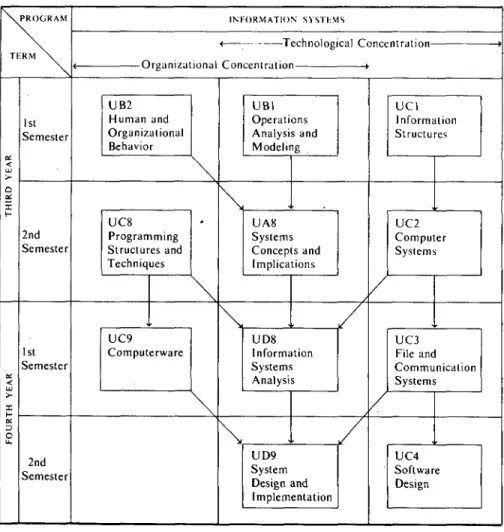
Course Group UB
In any case, the number is the same as that of the original, preceded by a " U. n The course titles are identical. These two combined courses replace in the organizational concentration the more extensive offerings of UC1, UC2, UC 3 and UC 4 in the technical option.
Course Group UC
Essentially the same professional prerequisites are required for the bachelor's degree in information systems, in both concentrations. Typical schedules incorporating these prerequisite courses for both the organizational and technological options are provided in section 5. The 11 courses prepared for the two bachelor's concentration options are listed in Figure 1. Of these, concentration options are listed in Figure 1. Of these , six are undergraduate versions of courses specified for the Master's programme: UB1, UB2, UC1, UC2, UC3, UC4.
Approach to the UC Courses. In the undergraduate program more emphasis is placed on programming
The roles and required structures of these courses are shown schematically in Figure 2, which also shows the order of the course through the last two undergraduate years. The remainder of this section provides brief descriptions for each of the 11 courses, which can be compared to the earlier descriptions of 13 courses [2, Sec.
Course UC1. Information Structures
Course UC2. Computer Systems
Course UC4. Software Design
Course UC8. Programming Structures and Techniques
Course UC9. Computerware
Course Group UA
Course UD8. Information Systems Analysis
Programs and Scheduling
- Undergraduate Program Scheduling
- Institutional Considerations
The organizational concentration, Figure 5(a), allows completion of the graduate program in one year and corresponds to the second year of the graduate program specified in the earlier report [2, Sec. These are created here in the same three categories: institutional considerations, course interactions, and instructional materials.
JA8 Systems
- Courses and Course Interactions
- Instructional Materials
- Tomorrow's manpower needs. Bureau of Labor Statistics, Bull
A main feature of the Master's program is the concept of the program as an integrated whole. For all these reasons, it is not practical to expect much integration of the course material that the program can achieve.
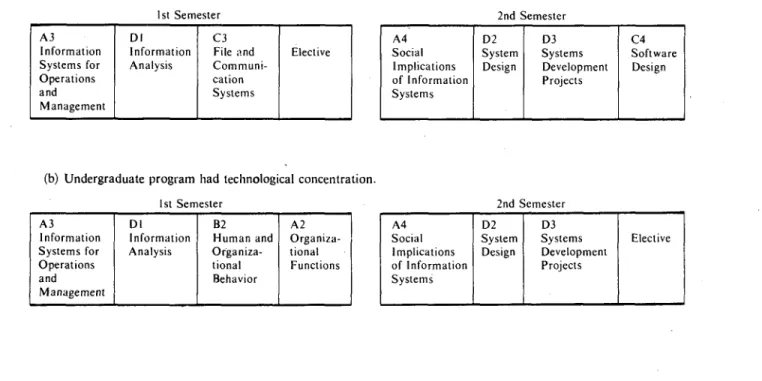
Appendix
Communication, linking, and sharing of programs and data (5%)
Programming language implementation structures (10%) Examples of the implementation of modeling structures in higher languages. Examples of the use of information structures (20%) Representation of information during execution; implementation of higher level language data structures.
UC9. Computerware Prerequisite: UC8
- Hardware modules: Bell and Newell (1971); Buchholz (1962);
- Operation software: Rosin (1969)
- Review of communication systems: Davenport (1971); Gentle (1965); Martin (1967); Martin (1969)
- Examples: Martin (1967); Parkhill (1966)
File and Communication Systems Function: G r u e n b e r g e r. Data Management Systems Review and Analysis: C O D A S Y L. Bibliography: References are in the combined bibliography provided below. A final article which presents the fundamental aspects of concurrent processes in computer systems. 1969) Elements of data management systems.
CURRICULUM '78
A Report of the ACM Curriculum Committee on Computer Science
Contained in this report are the recommendations for the undergraduate degree program in Computer Science
The core curriculum common to all computer sciencc undergraduate programs is presented in terms of elemen-
Key Words and Phrases: computer sciences courses, computer science curriculum, computer science educa-
Contents
- Introduction 2. Core Curriculum
- Introduction 2.2 Objectives
- Elementary Material
- Implementation Considerations 2.5 Sample Elementary Level Courses
- Introduction 3.2 Elementary Level
- Introduction
- Computer Science Requirements and Electives 4.3 Mathematics Requirements
- Other Requirements and Electives 5. Service Courses
- Introduction
- General Service Courses 5.3 Supporting Areas
- Introduction 6.2 Facilities
- presents computer science electives that may be used to round out an undergraduate program. In Sec-
- Core Curriculum 1 Introduction
- Computer Programming I CS 2. Computer Programming II
- Operating Systems and Computer Architecture 1 CS 7. Data Structures and Algorithm Analysis
- Organization of Programming Languages The structuring of the courses as to prerequisites is
- Objectives
- be able to write programs in a reasonable amount of time that work correctly, are well documented, and
- be able to determine whether or not they have written a reasonably efficient and well organized program;
- know what general types of problems are amenable to computer solution, and the various tools necessary
- be able to assess the implications of work performed either as an individual or as a member of a team;
- understand basic computer architectures;
- be prepared to pursue in-depth training in one or more application areas or further education in com-
- Computer Structure and Machine Language: in- cludes organization of computers in terms of I / O ,
- Data Representation: includes bits, bytes, words and other information structures; number representa-
- Symbolic Coding and Assembly Systems: includes mnemonic operation codes; labels; symbolic ad-
- Addressing Techniques: includes absolute, relative, base associative, indirect, and immediate address-
- Macros: includes definition, call, expansion of macros; parameter handling; conditional assembly
- Program Segmentation and Linkage: includes sub- routines, coroutines and functions; subprogram
- Linkers and Loaders: separate compilation of sub- routines; incoming and outgoing symbols; reloca-
- Systems and Utility Programs: includes basic con- cepts of loaders, I / O systems, human interface with
- Computer Programming I (2-2-3) The objectives of this course are
- Computer Programming II (2-2-3) Prerequisite: CS 1
- Debugging and Testing. ( 1 0 % )
- Introduction to Computer Systems (2-2-3) Prerequisite: CS 2
- Introduction to Computer Organization (3-0-3) or (2-2-3)
- Examinations. (5% )
- Introduction to File Processing (3-0-3) Prerequisite: CS 2
- Random Access. Physical characteristics of disk/
- Examinations. (5%)
- Operating Systems and Computer Architecture I (2-2-3)
- Data Structures and Algorithm Analysis (3-0-3)
- Algorithms Design and Analysis. Basic techniques of design and analysis of efficient algorithms for internal
- Organization of Programming Languages (3-0-3)
- Language Definition Structure. Formal language con- cepts including syntax and basic characteristics of
- Control Structures and Data Flow. Programming language constructs for specifying program control
- Examinations. ( 5 % )
- Computers and Society (3-0-3) Prerequisite: elementary core material
- History of computing and technology B. The place of the computer in modern society
- Survey of computer applications E. Legal issues
- Computers in decision-making processes G. T h e computer scientist as a professional
- Operating Systems and Computer Architecture II (2-2-3)
- Database Management Systems Design (3-0-3)
- Examinations. ( 5 % )
- Artificial Intelligence (3-0-3) Prerequisite: CS 7
- Examinations. ( 5 % )
- Algorithms (3-0-3)
- Examinations. (5 % )
- Software Design and Development (3-0-3) or (2-2-3)
- Theory of Programming Languages (3-0-3) Prerequisite: CS 8
- Scanners. Finite state grammars and recognizers
- Automata, Computability, and Formal Languages (3-0-3)
- Formal Grammars. Chomsky hierarchy grammars, pushdown acceptors and linear bounded automata
- Examinations. ( 5 % )
- Numerical Mathematics: Analysis (3-0-3) Prerequisites: CS 1 and MA 5
- Examinations. (5%)
- Numerical Mathematics: Linear Algebra (3-0-3)
- Microcomputer Laboratory B. Minicomputer Laboratory
- Telecommunications/Networks/Distributed Systems
- Systems Simulation
- Advanced Systems Programming G. Graphics
- Compiler Writing Laboratory I. Structured Programming
- Topics in Formal Language Theory M. Simulation and Modeling
- Operating Systems and Computer Architecture I
- Data Structures and Algorithm Analysis CS 8. Organization of Programming Languages
- Operating Systems and Computer Architecture II
- Database Management Systems Design CS 12. Artificial Intelligence
- Algorithms
- Software Design and Development CS 15. Theory of Programming Languages
- Mathematics Requirements
- Other Requirements and Electives
- Service Courses 1 Introduction
- Computer Applications and Impact (3-0-3)
- Databases: Establishment and use. Data definition and structures
- Errors: Types, effects, handling
- Languages: As appropriate, introduction to a busi- ness oriented language, a symbol manipulation lan-
- Concepts and Techniques Used in Solving Problems
- Projects and Examinations
This course provides a diverse sampling of theoretical computer science domains and their hierarchical relationships. Over time, some of the material must be integrated into previously specified courses or may replace entire subjects in the curriculum.
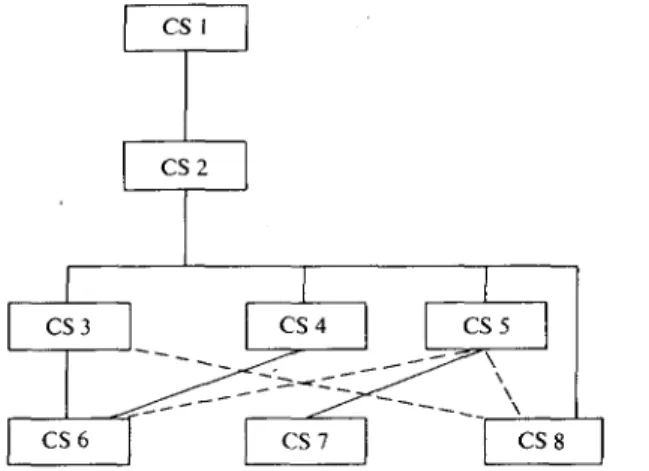
H a r b r o n , Anderson College Stephen Hedetniemi, University of Oregon Alex H o f m a n , T e x as Christian University Charles Hughes, University of Tennessee L a w r e n c e Jehn, University of Day t o n K a r l K a r l s t r o m , Prentice-Hall. Jack Minker, University of M a r y l en H o w a r d M o r g a n , University of Pennsylvania A b b e Mowshowitz, University of British C o l u m i a Michael Mulder, Bonneville Power Administration.
The ACM Committee on Curriculum in Computer Science has spent two years investigating master's de-
The ACM Committee on Curriculum in Computer Science has spent two years examining the graduate program.
Key Words and Phrases: computer science courses, computer science curriculum, computer science educa-
Contents 1. Introduction
- The Need for Masters Programs 3. Goals of Program
- Basic Intent
- Communication Skills 3.3 Current Literature Level
- Entrance Requirements
- Admission Requirements 4.2 Prerequisites
- Program Organization 1 "Course Work
- Culminating/Unifying Activity 5.3 Seminar
- Thesis or Project
- Comprehensive Examination 6. Resource Requirements
- Faculty
- Computing Equipment 6.3 Library
- Specializations 8. Conclusions
- Contributors B. Course Descriptions
- Introduction
- The Need for Master's Programs
- Goals 3.1 Basic Intent
- Communication Skills
- Current Literature-Level
- Professionalism
- Entrance Requirements 4.1 Admission Requirements
- Prerequisites
- Program Organization 5.1 Course Work
- Programming Languages
- Software Design and Development CS 15 Theory of Programming Languages
- Formal Methods in Programming Languages
- Architecture of Assemblers CS 25 High Level Language Computer
- Operating Systems and Computer Architecture CS 10 Operating Systems and Computer
The scope and extent of existing computer science graduate programs have been recently surveyed [4, 7]. The primary emphasis of the program should be on the concepts, theory and practice of computer science.
CS 22 Performance Evaluation
- Analytical Models for Operating Systems CS 24 Computer Communication Networks and
- Microcomputer Systems and Local Networks
- Theoretical Computer Science CS 13 Algorithms
- Automata, Computability, and Formal Languages
- Applied Combinatorics and G r a p h Theory CS 30 Theory of Computation
- Data and File Structures
- Database Management Systems Design CS 31 Information Systems Design
- Information Storage and Access CS 33 Distributed Database Systems
- Computers and Society CS 12 Artificial Intelligence
- Numerical Mathematics: Analysis CS 18 Numerical Mathematics: Linear Algebra
- Students with strong undergraduate backgrounds in computer science may have already satisfied some of
This report provides some recommendations on what a master's degree in Computer Science should and should not be. The Computer Science faculty at an institution should be the final determiner of what should and should not be in the program.
Appendix A Contributors
The committee started by preparing a model syllabus for computer science master's programs corresponding to the model syllabus for bachelor's programs described in [2]. We attempted to develop separate model curricula for academic, professional, and specialization programs, but could not agree on any of them.
Appendix B
We quickly determined that even a small group of computer scientists could not agree on a model curriculum. Next, we tried to develop a list of core concepts that every master's student should know.
Course Descriptions
- Computer Programming I CS 2 Computer Programming II
- Operating Systems and Computer Architecture I CS 7 Data Structures and Algorithm Analysis
- Operating Systems and Computer Architecture II CS 11 Database Management Systems Design
- Algorithms
- Software Design and Development CS IS Theory of Programming Languages
- Automata, Computability, and Formal Languages CS 17 Numerical Mathematics: Analysis
- Numerical Mathematics: Linear Algebra
- Compiler Construction (3-0-3) Prerequisite: CS 8
- Formal Methods in Programming Languages (3-0-3) Prerequisite: CS 8
- Architecture of Assemblers (3-0-3) Prerequisite: CS 6
- Performance Evaluation (3-0-3) Prerequisite: CS 6
- Analytical Models for Operating Systems (3-0-3) Prerequisite: CS 6
- Computer Communication Networks and Distributed Processing (3-0-3)
- High Level Language Computer Architecture (3-0-3) Prerequiste: CS 6
- Large Computer Architecture (3-0-3) Prerequisite: CS 6
- Real-Time Systems (3-0-3) Prerequisite: CS 6
- Microcomputer Systems and Local Networks (2-2-3) Prerequisite: CS 6
- Applied Combinatorics and Graph Theory (3-0-3) Prerequisites: CS 7, 13
- Theory of Computation (3-0-3) Prerequisites: CS 7, 16
- Information Systjem Design (3-0-3) Prerequisites: CS 6, 11
- Information Storage and Access (3-0-3) Prerequisites: CS 6, 11
- Distributed Database Systems (3-0-3) Prerequisites: CS 11, 24
- Pattern Recognition (3-0-3) Prerequisites: CS 6, 7
- Computer Graphics (3-0-3) Prerequisites: CS 6, 7
- Modeling and Simulation (3-0-3) Prerequisites: CS 6, 7
- Introduction to Symbolic and Algebraic Manipulation (3-0-3) Prerequisite: CS 7
Curriculum Recommendations for Graduate Professional Programs in Information Systems, a report from the ACM Curriculum Committee on Computer Education for Management. Curriculum '78: Recommendations for the Computer Science Bachelor's Program, a report by the ACM Curriculum Committee Informatics.
A Report of the ACM Curriculum Committee on Information Systems
The report outlines career opportunities in Informa- tion Systems and lists brief descriptions of positions
The need for an Information Systems program and prob- lem areas with respect to teaching information systems
Key Words and Phrases: education, management systems, systems analysis, management information sys-
- Career Opportunities in Information Systems The purpose of IS curricula is to prepare systems
- Need for an Information Systems Degree Program Computer-related occupations range from those re-
- Analysis of Organizational Systems B. Background for Systems Development
- courses and course sequence required for the undergraduate program are described in Figure 2 (repro-
- A Survey of Existing Degree Programs in Information Systems
- colleges and universities offered 70 programs at the bachelor's level and 54 programs at the master's,
- Criteria for Inclusion of Degree Programs
- Lists of Institutions Meeting the Criteria
- Summary
The system librarian is responsible for:. management and maintenance of the files and programs that are developed and maintained in the systems. The most critical problem area appeared to be the content of the systems analysis and design courses.
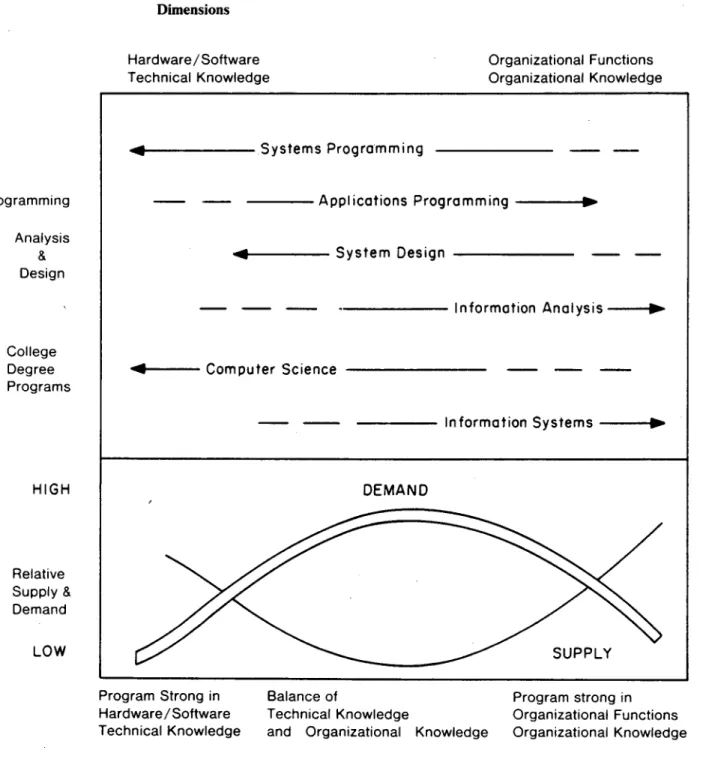
Recommendations and Guidelines for an Associate Level Degree Program
In Computer Programming
A Report of the ACM Committee on Curriculum for Community and Junior College Education
Introduction 1 Purpose
- Historical Perspective
Computer Programming Jobs: Prospects, Skills, and Environments 1 Duties of the Computer Programmer
- J o b Descriptions 2.3 J o b Environment
- Career Paths and Advancement 2.5 Employment Supply and Demand
Objectives of the Curriculum 1 Purpose of the Curriculum
- Required Computer Content
- Principles and Techniques of Programming 4.1.2 Programmer Environment
- Optional Computer Content 4.3 Related Content
- Design Considerations
- M a j o r Programming Language 4.6 Access to Equipment
- Structured Programming 5. Resources for Implementation
- Organizational Matters 5.2 Faculty and Staff
- Adaptation for Continued Relevancy 6. Articulation
- Industry
- Other Educational Institutions 6.3 The Computer Profession
A . Reference Materials
Computer Programming as a Career 2. Instructional Bibliographies
Periodicals and Newsletters B. Curriculum Implementation Material
Contributors and Workshop Participants F. ACM Committee on Curriculum for Community
Computer Programming Jobs: Prospects, Skills, and Environment
- Duties of the Computer Programmer
- Job Descriptions
- Job Environment
- Career Paths and Advancement
- Employment Supply and Demand
- Qualities for Success
- Performance Objectives
The Committee attempted to work within the mission of the community and junior colleges: to serve community needs. The main objective of the curriculum is to produce a graduate who will be able to write application programs.
Content of the Curriculum
- Principles and Techniques of Programming The content recommended for a core curriculum, given
- Programmer Environment
- Optional Computer Content
- Related Content
Emphasis should be placed on the role and responsibility of the programmer in the successful analysis, design, implementation, and maintenance of a computer-based information system. The student must be made aware of the role and responsibility of the programmer in the organization and in society as a whole.
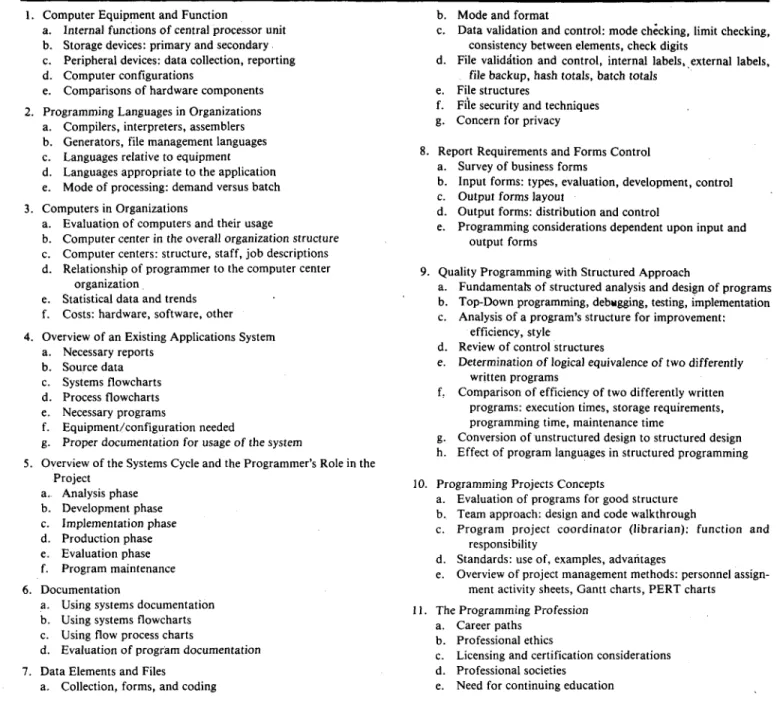
English Communications
Some students may want to choose a numerical methods course, while others may want to learn more about operating systems, data communications, or systems analysis. Based on the documentation of such an investigation, the institution can include additional topics in the core requirements.
Business Knowledge
Colleges serving communities with relatively advanced high school computer work may choose to design their curriculum to include more advanced courses. These topics are not intended to reflect courses although some may warrant a full course.
Mathematical Knowledge
Students choosing an applied science emphasis would also choose the traditional mathematics course sequence. Students who intend to transfer should select mathematics courses appropriate for their transfer program and institution.
Applied Area of Specialty
However, those expecting to transfer into business-related fields will usually find that the courses recommended in this report are sufficient for continued study in quantitative methods.
General Education
- Major Programming Language
- Access to Equipment
- Structured Programming
- Resources for Implementation
- Organizational Matters
- Faculty and Staff
- Equipment and Access
- Instructional Materials
- Adaptation for Continued Relevance
The student must be familiar with accounting systems for work used to record time consumption, storage space consumption and consumption of consumables for a computing facility. This person may be faculty or staff, depending on the organizational structure of the academic department and the computing equipment used at the institution.
Faculty
Development involves a large time commitment on the part of the faculty; this commitment must be recognized by the institution and assigned as part of the faculty load. Many of the changes that occur are transparent to the general computer user, but they are part of the computer professional's livelihood.
Equipment
Articulation 1 Industry
- Other Educational Institutions Secondary Schools
Surveys of industry needs in the community being served should be made and viewed in light of the offerings of other neighboring educational programs in an effort to. Subjects and programs must be reviewed periodically, so that the high school student is kept informed of the equivalence or non-equivalence of the subject content.
Four-Year Programs
University faculty should maintain close contact with respective departments at the high school level to improve articulation. High school students who complete courses equivalent to the materials recommended in this report should be able to receive early placement in the program, early admission, or a means of earning college credit through exams.
Other Two-Year Programs
Accreditation Agencies
The Computer Profession
PIP Newsletter, Informational Publication of the Project on Information Processing I, 1 (Feb. 1963) 1. Data Processing Technology - A Proposed Two-Year Post-High School Curriculum. Department of Health, Education, and Welfare, Office of Education, stock number U.S. Electronic Data Processing — 1, a suggested two-year post-secondary curriculum for computer programmers and business applications analysts.
Appendix A. Reference Materials
Computer Programming as a Career
Instructional Bibliographies
Newsletters and Periodicals
An overview of ACM guidelines and recommendations for a community and junior college career program in computer programming.
Appendix D. Sources of Job Descriptions
Workshop Participants, May 27-28, 1976, Gloucester Point, Virginia
Workshop Participants, August 1977, Gloucester Point, Virginia
Polay, Washtenaw Community College, Ann Arbor, Michigan Doug Ruby, McDonnell-Douglas Automation Company, Californien Martin Sandman, National Cash Register, Inc. Szweda, Monroe Community College, Rochester, New York James Tuedio, Pasadena City College, Pasadena, Californien Gerald M.
Appendix F
Loveland, Duke University, North Carolina Bernard Luskin, Coast College District, California Sister Patricia Marshall, Xavier University of Louisiana William McCartin, Noxell Corporation, Baltimore, Maryland Daniel D.
ACM Committee on Curriculum for Community and Junior College Education, 1981
